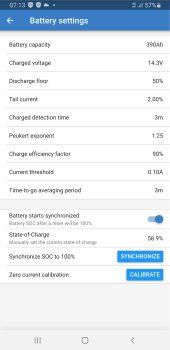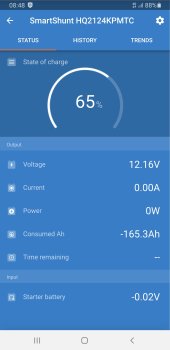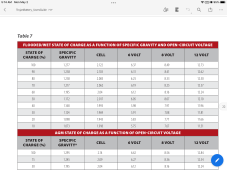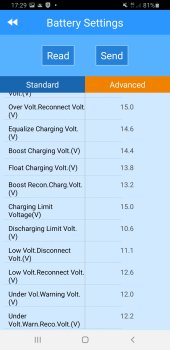OK one step at a time:
Batteries - Those are sealed/MF Calcium batteries which require special charging often a specialized charger that most people don't have. I found some info on Hankook's website. They give two ways to charge the batteries:
1. Constant current - based on state of charge of batteries. They want you to measure open circuit voltage, then set a specialized charger to give a constant current based on state of charge. For example, if battery is OCV 12.0v you should give it (each battery) 6.5a for 18 hours. (I had to extrapolate their chart to get a 130ah battery.) Obviously this is impossible with your setup.
2. Constant voltage - They call for 16v for 24 hours. This is of course also impossible with your setup.
Hankook AtlasBX Battery Maintenance information. How to handle battery, Installation and recharging, and Battery testing procedure.

www.hankook-atlasbx.com
So it would seem that we have established that you are not fully charging your batteries thus any manual sychronization that you have done is false. If you manually synchronized the smartshunt to 100% when the batteries were NOT full it would starting counting down amp-hours but the battery bank is not actually starting with 390 a-hr so it makes sense that after 165 a-hours the voltage is lower than you expect.
So the battery monitor will never work well if you never fully recharge your batteries so you have a broader system design issue, not just a smartshunt programming issue.
That said, you also will continue to have problems until you accept the facts about when auto synchronization occurs. you can't remain "under the impression that it will happen when voltage hits 14.3v for a period of time." Perhaps you should look at the book again. The important part of the smartshunt knowing when the batteries are full is that they stop accepting current (current falls below tail current even though voltage is above charged voltage.) Think about it - batteries are noted to be full when you are pushing voltage but current won't move as there is no space.
Based on the float voltage your have set (not sure where this came from?) in your MPPT controller the SmartShunt charged voltage should be 13.6v.
However with a small scale, and possibly undersized, solar setup the numbers jump around due to sun conditions and it can be difficult to make a smartshunt work smoothly unless you have another 120v charger you can use to fully charge the batteries periodically.
I'll paste a few things from the book for you:
10.3.4. Incorrect state of charge reading An incorrect state of charge can be caused by a variety of reasons. Incorrect battery settings The following parameter(s) will have an effect on the state of charge calculations if they have been set up incorrectly: • Battery capacity • Peukert exponent • Charge efficiency factor Incorrect state of charge due to a synchronisation issue: The state of charge is a calculated value and will need to be reset (synchronised) every now and then. The synchronisation process is automatic and is performed each time the battery is fully charged. The battery monitor determines that battery is fully charged when all 3 "charged" conditions have been met. The "charged" conditions are: • Charged voltage (Voltage) • Tail current (% of battery capacity) • Charge detection time (minutes) Practical example of the conditions that need to be met before a synchronisation will take place: • The battery voltage has to be above 13.8V • The charge current has to be less than 0.04 x battery capacity (Ah). For a 200Ah battery this is 0.04 x 200 = 8A • Both above conditions have to be stable for 3 minutes If the battery is not fully charged or if the automatic synchronisation does not happen, the state of charge value will start to drift and will eventually not represent the actual state of charge of the battery. The following parameter(s) will have an effect on automatic synchronisation if they have been set incorrectly: • Charged voltage • Tail current • Charged detection time • Not occasionally fully charging the battery
10.3.11. Synchronisation issues If the battery monitor does not synchronise automatically,
one possibility could be that the battery never reaches a fully charged state. Fully charge the battery and see if the state of charge eventually indicates 100%. Another possibility is that the charged voltage setting should be lowered and/or the tail current setting should be increased. It is also possible that the battery monitor synchronises too early. This can happen in solar systems or in systems that have fluctuating charge currents. If this is the case change the following settings: • Increase the “charged” voltage to slightly below the absorption charge voltage. For example: 14.2V in case of 14.4V absorption voltage (for a 12V battery). • Increase the “charged detection time” and/or decrease the tail current to prevent an early reset due to passing clouds.








